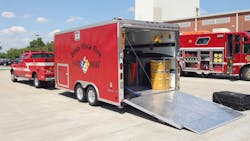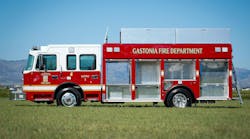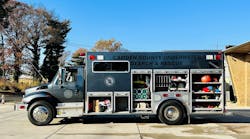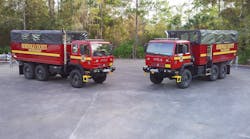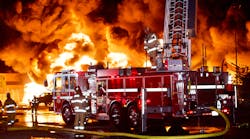Northwest Arkansas is one of the fastest growing and most dynamic regions in the United States. It is home to Wal-Mart, J.B. Hunt Trucking Co., Tyson Foods and the University of Arkansas. With the beautiful Beaver Lake and the majestic Ozark Mountains, the northwest Arkansas region, inspired by its surroundings, is an up-and-coming leader in business, education, sports, tourism and arts and culture.
In the mid-1980s, the Northwest Arkansas Metropolitan Fire Chiefs Association contemplated how to comply with the mandates of newly passed legislation by Congress titled the Emergency Planning and Community Right-to-Know Act (EPCRA), also known as SARA Title III. County judges in Arkansas are responsible for hazardous materials response planning in their jurisdictions and are the chief administrative officers in their counties.
Regional team formed
The idea was put forth by the Metro Chiefs and county judges for Benton and Washington counties (the largest and most populated in northwest Arkansas) to form a regional hazardous materials response team. They felt local departments did not have the financial resources or personnel to have individual teams. The plan was taken to each legislative body in the towns and two counties for approval. Initially, there was some resistance to the plan, but in the end all jurisdictions agreed to the regional team and an intergovernmental agreement was signed by all.
During the initial planning, it was determined that $200,000 would be required to create a team and $150,000 a year to maintain it. Funding for the team was derived from a 38-cents per-capita assessment for each jurisdiction per year to support operational costs. Communities within the response area would pay up to $21,266, depending on the population. Bentonville paid $14,470 in 2010, Bella Vista $10,051, Siloam Springs $5,715 and Rogers $21,266. Washington County’s attorney and treasurer handled legal issues and the collected funds for the team.
Six fire departments within the two counties assigned personnel to respond as part of the team. Bella Vista, Bentonville and Siloam Springs provided four personnel each and a team leader. Fayetteville and Rogers provided five personnel each and a team leader. Springdale provided seven team members and a team leader. Training was conducted in house by a full-time team training officer and a team chief was appointed to coordinate daily operations. The Springdale Fire Department was centrally located in the response area and had available space and agreed to host the hazmat response unit. The Northwest Arkansas Hazardous Materials Response Team went into operation in1989 and operated successfully for more than two decades. It should also be noted that the municipal areas within the regional team’s protection area border one another, much like the suburbs of larger cities around the country. Response times for the closest personnel and local support equipment was less than 30 minutes and the Hazardous Materials Unit housed in Springdale might take 30 to 90 minutes, depending on where in the two-county area it was responding and traffic conditions.
Return to local jurisdictions
In the late 2000s, several chief officers retired and new chiefs were promoted or newly hired in several northwest Arkansas fire departments. The longstanding concept of a regional hazmat team was no longer supported by all members of the Metro Chiefs Association. Following extensive discussions about the existing regional hazmat team, the chiefs voted to disband the team and return the responsibility for hazmat response to the local level.
Under the new hazmat response plan, each county would be responsible for its own hazmat response. Larger departments would form local teams and provide protection for smaller departments and unincorporated areas in each county. Within Washington County, the Fayetteville and Springdale fire departments formed hazmat teams. Portions of Springdale are also located in Benton County. In Benton County, the Bentonville, Bella Vista, Rogers and Siloam Springs fire departments formed hazmat response teams. Thus, one regional hazmat team for the two-county area has now evolved into six individual hazmat teams. Personnel who were shared among the departments now staff their own teams, creating the need for additional personnel to be trained and equipped. One response unit and associated equipment for the regional team has become six individual response units and six sets of associated equipment.
Alliance formed
Since the regional team was disbanded, two departments in Benton County have formed an alliance for the purposes of training, coordination of equipment purchase and response to hazmat incidents – Bentonville and Bella Vista. Located north of Bentonville, Bella Vista is just south of the Missouri state line. Bentonville, the home of Wal-Mart, is south of Bella Vista, west of Rogers and east of Siloam Springs. Bentonville and Bella Vista provide hazmat response for their jurisdictions, Northwest Arkansas Regional Airport and the cities of Cave Springs, Centerton and Highfill.
The startup of the newly created team has cost Bentonville $26,676 in salaries, $25,000 for equipment first year ($15,000 of that was from sale of the regional team’s equipment), $16,000 for training and $55,000 for monitoring instruments (from Homeland Security Grant Program funding). Bentonville placed its hazmat team in operation on Jan. 1, 2013 and responded to 80 hazmat incidents during its first year of operation. Total hazmat response calls have included fuel spills, gas odors and leaks. Engine companies respond to fuel spills and can handle up to 45 gallons. Engine and ladder companies each carry a four-gas meter, thermal imager and absorbent materials to clean up small spills. One person from the hazmat team is on site of any fuel spill. Larger spills require the response of the full Bentonville hazmat team.
Usually, six hazmat technicians are on duty each shift. A total of 18 technician-level personnel located throughout the department can be recalled to duty if necessary. Bentonville’s hazmat team is not dedicated, so Station 1 personnel man the hazmat unit for hazardous materials calls. Hazmat team members are required to successfully complete the 80-hour Arkansas Emergency Management technician-level training course. An additional 80 hours of hazmat chemistry is also required. Specialists on highway tankers are trained at the Association of American Railroads (AAR) training center in Pueblo, CO. Team members have taken hazmat specialty classes at Texas A&M University and the Federal Emergency Management Agency (FEMA) Center for Domestic Preparedness in Anniston, AL. Firefighters in Bentonville who are not assigned to the hazmat team are trained at the operations level.
Bentonville’s population increased almost 80% between 2000 and 2010, with an estimated 2014 population of 40,440, an increase of 15% since 2010. The population increases each weekday when more than 33,000 Wal-Mart employees arrive for work from outside Bentonville.
Bentonville components
The Bentonville Fire Department has expanded from a single station to five stations with a sixth under construction and a seventh in the planning stages. A new Fire Station 1 opened in June 2008 and features a six-bay apparatus room with a vehicle exhaust extraction system, wash bay, 15 bunkrooms, a large day room, a stainless-steel kitchen with a separate dining room, a 1,800-square-foot training room, a lobby museum, administrative offices and a five-level training tower, and is fully fire sprinkled. (This station was the 2008 Station Styles Gold Medal winner in the Career Stations category, presented by Fire Chief Magazine.)
The Bentonville Fire Department was founded in 1887 and was a largely volunteer organization until the first driver/operator was hired in 1922. Ambulance service was added to the department’s responsibilities in 1977. The department joined the regional hazmat team in 1989 and formed a 12-person technical rescue team in 1995. The Bentonville Fire Department is under the command of Chief Brent Boydston, who joined it in 1984 as a part-time employee and was hired full time in 1989. Boydston rose through the ranks and was appointed chief in April 2012. Bentonville is an ISO Class 2 fire department with 74 uniformed personnel and currently 10 paid-on-call personnel (it has authorization for 12). Bentonville’s paid-on-call personnel are often the source of full-time hires on other departments.
Out of its five stations, Bentonville responds to approximately 6,200 calls each year. It operates four engine companies, two ladders (quints) and six squads (paramedic ambulances). Station 1 houses Truck 1, Squads 1 and 10, Rescue 1, Engine 1, Engine 219, Support 1, Battalion 1 and a motorized rescue cart. Fire Station 2, which opened in 1989 and was renovated in 2012, houses Squad 2 and Quint 2. Fire Station 3, opened in 1996, houses Squad 3 and Engine 3 and was designed with a maintenance pit for fire and EMS apparatus. Fire Station 4 opened in 2001 as the city’s first two-story station. It houses Engine 4, Squad 4 and Brush 4. Fire Station 5 opened in 2005 and houses Engine 5, Squad 5 and Brush 5. This station is fully fire sprinkled.
Support Unit 1 is the primary hazardous materials response vehicle for the Bentonville Fire Department and is housed at Station 1. Support Unit 1 is a 2000 E-ONE Cyclone II 21-foot walk-in vehicle. Most of the hazmat equipment is carried in the walk-in area. Chemical protective clothing includes Kappler Provent 7000 coveralls for splash, Kappler Z1000Xp for Level B and Kappler Z500 NFPA for Level A. Respiratory protection is provided by Scott self-contained breathing apparatus (SCBA) with 45 minute bottles and particulate filters, PAPR and in-line supplied air. In-line air and bottle-filling air is provided by an onboard air supply system located on Support Unit 1. The cascade system is capable of refilling 80 bottles. In-suit communications are provided by Motorola XPR 6550 digital with PTT, throat microphone and ear bud attachments. Monitoring instruments include four-gas Q8Rae II, four-gas MultiRAEs with PID, MiniRAE 3000 PID, ChemRAE, Ahura Defender Ramon, Guardian biological reader and Smith’s Detection Multi-Mode Threat Detector for TIC, CWA narcotics and explosives.
Bentonville is in the process of obtaining a grant for a mobile mass spectrometer. Reference materials used by the Bentonville hazmat team include the Emergency Response Guidebook, National Institute for Occupational Safety and Health (NIOSH) Surviving the Hazardous Materials Incident and WISER HazMat Pocket Guide and HazMat Segregation and Pipeline Emergencies software.
Primary hazardous materials exposures in Bentonville and Benton County are 10 million square feet of operational space used by Wal-Mart on a daily basis and potential roadway incidents. Chemical, biological, radiological, nuclear and explosive (CBRNE) events are the primary concern with the Wal-Mart complex. Suspicious packages at the Wal-Mart mailing facility are one of the major risks in terms of CBRNE events. Interstate 49 runs through Benton County from Bella Vista at the Missouri border and through Bentonville, Rogers and Springdale. In addition to any hazardous materials transported on Interstate 49, the TransMontaigne, Razorback pipeline and terminal on average fill and send on their tankers carrying a combined total of 750,000 gallons of motor fuel per day. This facility also receives 60,000 gallons a day of ethanol used as a motor fuel additive.
In February 2012, a Commodity Flow Study was conducted on Interstate 540 (now called Interstate 49). The study was conducted over two days, the first from 11:30 A.M. to 7:30 P.M. and the second day from 9 A.M. to 3 P.M. Results of the study showed various petroleum products, propane, ethyl lactate, oxygen, ammonium nitrate, anhydrous ammonia, methacrylic acid and other corrosives, nitrogen and CO2, to name a few. Bentonville has a propane plant for distribution of propane to residential and business occupancies. There are no railroad facilities in Bentonville’s primary response area, although two railroads serve northwest Arkansas. Kansas City Southern mainly transports coal and the Arkansas/Missouri railroad transports hazardous materials through portions of Benton County.
Bella Vista responses
The Bella Vistas Fire department was established in 1969. Their first response area is primarily residential and business occupancies. Under the command of Chief Stephen Sims, 38 uniformed personnel respond out of three fire stations. Station 1 is in the town center with seven firefighters on duty. Station 2, located on the east side, is staffed with three firefighters. Station 3 is in the Highlands area of town and has two firefighters on duty. A fourth station is in the planning stages. Sims joined the department in 1995 and was appointed chief in 2006.
Bella Vista operates two engine companies, one ladder, four squads, one heavy rescue, a water rescue and hazmat trailer pulled by a pickup truck.
Bella Vista’s population is 28,500 and the fire department covers an area of 63 square miles for fire and EMS coverage and 125 square miles for hazmat response. It also protects the communities of Gravette, Maysville, Pea Ridge and Sulpher Springs. There are 38 career firefighters on the department and 20 of those are paramedics and 17 are EMTs. The department also has six paid-on-call firefighters. Each shift, 12 career firefighters are on duty.
The Bella Vista Fire Department has nine trained hazmat technicians, with three on duty each shift. Firefighters and EMS personnel are trained to the hazmat operations level. Kappler Level A suits are used by Bella Vista hazmat personnel with SCBA and one-hour bottles. Monitoring equipment includes radiation detectors, photo ionization detectors and a four-gas monitor. The department relies on Bentonville for additional monitoring capability. An air-supply system is carried on the rescue truck. Bella Vista carries a Chlorine A Kit and Midland Emergency Response Kit along with other typical hazmat response equipment. The primary hazmat exposure for fixed facilities is propane. There is no natural gas service in Bella Vista, so all requirements for fuel are met by the use of propane. Highway transportation is the other main hazmat exposure.
For additional information about the Bentonville Fire Department, contact Deputy Chief Kevin Boydston at 479-271-3151; for the Bella Vista Fire Department, contact Battalion Chief Jim Johnson at 479-855-8249.
